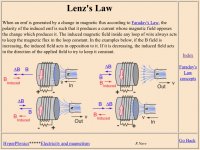The shortening ring requires he intermediary of the pole piece in order to work.Late response, sorry.
The shorting ring tries to prevent change of the flux through it. If the vc is stationary and driven at some frequency, the ring will fight that changing flux.
If the vc has DC, but is moving with respect to the ring, the ring will again fight the changing field, eddy braking.
If I power the vc with both LF high excursion and hf low excursion, the ring will fight both frequencies at the same time. But interesting is that the vc is now dragging a hf magnetic field through the ring at some velocity.
Jn
The time varying flux going through the shortening ring is generated by the time varying current going through the voice coil. This is the same for all frequencies (to the extent the pole piece material is linear).
The hf field dragged by the VC through the ring cannot have a significant impact when you consider the direction of the flux lines generated by the voice coil. They are coincident with the direction of the voice coil movement. In other words, voice coil movement does not lead to time varying flux through the shortening ring. So no currents are generated. Idealized situation of course.
But even then, there might be some effect in non-idealized situations, I think I mentioned so a couple of posts ago. At any rate, it is a side show, and not how a shortening ring works.
Exactly, my point also.Sorry but the Lenz' law explanation is plainly false if it is claimed to dictate that the ring flux opposes and counteracts the original vc flux. As already shown, these two remain always at 90 degree phase difference, as forced by Ampere's and Faraday's laws and also basic transformer theory.
The ring current and its consequent image current in the primary coil are another matter, and these are really in antiphase so that their magnetic effects cancel out, leaving the original vc flux unchanged (like the magnetizing flux in a power transformer remains unchanged).
It actually does two things.
Through the pole tip, it controls the magnetic circuit flux variation caused by the vc.
It also constrains the magfield of the vc, lowering it's inductance.
Jn
Through the pole tip, it controls the magnetic circuit flux variation caused by the vc.
It also constrains the magfield of the vc, lowering it's inductance.
Jn
I am recalling Pass had done measurements on a bunch of speaker elements comparing voltage VS current drive with distortion graph plots, have been searching the net for a while but can't find the article any more, anyone acquainted with it?
Funny, NP talks about adding a resistor in series with the (big) amp rather than real,current mode control output.
I’ve heard it from a number of folks that lowering the damping improves the sound and especially on horns.
Might be some thing I’ll try - I have a few high power 10 Ohm resistors around.
I’ve heard it from a number of folks that lowering the damping improves the sound and especially on horns.
Might be some thing I’ll try - I have a few high power 10 Ohm resistors around.
The Bob Carver / Stereophile Editors "Transfer Function Challenge" was a victory for Bob Carver, who made a couple mods to his his Class-AB poweramp with SMPS supply, and successfully duplicated the sound of a Conrad Johnson tube power amp. The most significant change? He installed a 1.5 ohm series resistor between the amp and the speaker binding post. There were others but that was the biggie.
Of course they backtracked after a few weeks of (sighted) listening and decided he had not REALLY duplicated the Conrad Johnson. Except for those twenty thousand hardcopy issues of the magazine they printed initially.
Of course they backtracked after a few weeks of (sighted) listening and decided he had not REALLY duplicated the Conrad Johnson. Except for those twenty thousand hardcopy issues of the magazine they printed initially.
^ Bill, I saw that too but it's not the one, it's quite some time ago so I hope I didn't mix up names or so..
I'm very happy more attention is made to the actual sound. I hope unclear testimonies such as stated becomes firmly understood once interested people start sharing their measurements.... I’ve heard it from a number of folks that lowering the damping improves the sound and especially on horns...
Some down time so I can answer.
The shorting ring will fight any time varying flux that tries to go through the conductive loop, this is Lenz's law. The pole piece is carrying the flux that travels the magnetic circuit. A short around the pole piece uses Lenz exclusion to minimize flux variation in the magnetic circuit.
If you go back to my initial post, I mentioned shorted turns as causing inductance to drop fast with frequency. Someone mistakenly thought it was shorted voice coil. It was not. If there is any metal that wraps around the flux path and it is fully conductive, that is considered a shorted turn. Think of a toroidal transformer where the bolt through the center accidentally contacts the chassis above the toroidal, it causes a single turn short.
Lenz effect only fights the time varying flux because of the short. If it is through air, it doesn't matter. The permeability of the channel has no bearing.
Second, if the vc is over the ring, the end of the vc is where there is a field gradient, and velocity does indeed drag the gradient over the shorting ring, inducing eddies, Lenz, and dragging of flux with braking.
That said, I do enjoy dialogue with you. While inaccurate, I find your statements and questions to be very intelligent. (I am not trying for condescending, but rather, expressing admiration).
Cheers,
jn
No, the shorting ring does not require the pole piece to work.The shortening ring requires he intermediary of the pole piece in order to work.
The shorting ring will fight any time varying flux that tries to go through the conductive loop, this is Lenz's law. The pole piece is carrying the flux that travels the magnetic circuit. A short around the pole piece uses Lenz exclusion to minimize flux variation in the magnetic circuit.
If you go back to my initial post, I mentioned shorted turns as causing inductance to drop fast with frequency. Someone mistakenly thought it was shorted voice coil. It was not. If there is any metal that wraps around the flux path and it is fully conductive, that is considered a shorted turn. Think of a toroidal transformer where the bolt through the center accidentally contacts the chassis above the toroidal, it causes a single turn short.
Lenz effect only fights the time varying flux because of the short. If it is through air, it doesn't matter. The permeability of the channel has no bearing.
There are two cases. First, if the ring is over the iron and not anywhere near the vc, then you are correct, the ring does not see the velocity.The hf field dragged by the VC through the ring cannot have a significant impact when you consider the direction of the flux lines generated by the voice coil. They are coincident with the direction of the voice coil movement. In other words, voice coil movement does not lead to time varying flux through the shortening ring.
Second, if the vc is over the ring, the end of the vc is where there is a field gradient, and velocity does indeed drag the gradient over the shorting ring, inducing eddies, Lenz, and dragging of flux with braking.
I look forward to the day when you learn how they actually work. I am not sure what your sources are, but You need to acquire better sources.At any rate, it is a side show, and not how a shortening ring works.
That said, I do enjoy dialogue with you. While inaccurate, I find your statements and questions to be very intelligent. (I am not trying for condescending, but rather, expressing admiration).
Cheers,
jn
Last edited:
I try to understand how one designs a bass reflex cabinet with a specific damping factor. If I go for a Q value of .7071, what does that mean when I hook up an amp with an impedance of 1 milliohm?Funny, NP talks about adding a resistor in series with the (big) amp rather than real,current mode control output.
I’ve heard it from a number of folks that lowering the damping improves the sound and especially on horns.
Might be some thing I’ll try - I have a few high power 10 Ohm resistors around.
Shouldn't I be designing the box with a specific amp impedance in mind?
Sigh, that is why I like FL horns..
Jn
This may be old news here, but I just learned that regular wire is now passe:
High Fidelity Cables
Howie
High Fidelity Cables
Howie
I try to understand how one designs a bass reflex cabinet with a specific damping factor. If I go for a Q value of .7071, what does that mean when I hook up an amp with an impedance of 1 milliohm?
Shouldn't I be designing the box with a specific amp impedance in mind?
Sigh, that is why I like FL horns..
Jn
The design is based on voltage source assumption. In case you use a standard solid state feedback amplifier, the assumption is fulfilled. 1 milliohm is a perfect voltage source for the vented box speaker. A cable would have higher impedance than the amplifier.
Last edited:
Very far afield, but if I could ask a tangential question: J. D'Appolito (who invented the geometric solution to the axial radiation issues posed by Linkwitz) designed a high level crossover between a direct radiator and a small horn loaded tweeter, saying that the tweeter had one less phase quadrature than the woofer.Sigh, that is why I like FL horns.
This is two steps away from the current discussion, but any comments would be greatly enjoyed. Of course, Joseph D'Appolito knows whereof he speaks, but what does it mean?
Much thanks, as always,
Chris
Last edited:
Feels like an up time to respond to youSome down time so I can answer.
No, the shorting ring does not require the pole piece to work.
The shorting ring will fight any time varying flux that tries to go through the conductive loop, this is Lenz's law. The pole piece is carrying the flux that travels the magnetic circuit. A short around the pole piece uses Lenz exclusion to minimize flux variation in the magnetic circuit.
If you go back to my initial post, I mentioned shorted turns as causing inductance to drop fast with frequency. Someone mistakenly thought it was shorted voice coil. It was not. If there is any metal that wraps around the flux path and it is fully conductive, that is considered a shorted turn. Think of a toroidal transformer where the bolt through the center accidentally contacts the chassis above the toroidal, it causes a single turn short.
Don't worry, I always understood your misunderstanding perfectly, you expressed it clearly. At least your story progresses. Indeed, a short around the pole piece minimizes flux modulation in the pole piece because all flux variations set up an opposing current in it. This is what EMT and I have been arguing all along.
Lenz effect only fights the time varying flux because of the short. If it is through air, it doesn't matter. The permeability of the channel has no bearing.
Yes, it does matter greatly, this is at the core of your misunderstanding. An easy Sunday morning experiment can shed light on this. One needs an air coil, a piece of copper tubing and a piece or iron.
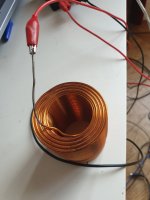
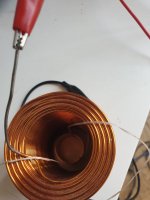
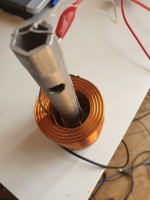
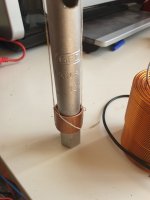
Measurements @ 1kHz produced the following results:
Bare coil: 2.537 mH
Coil with ring inside 2.447 mH
Coil with iron inside 4.346 mH
Coil with iron with ring inside 2.832 mH
The ring inside the coil without pole piece has a small effect, which is to be expected. It is an air core transformer, so this is what you get. However, with the iron inside, the effect of a shortening ring is huge. It almost negates completely the rise of inductance caused by the inclusion of the bare piece of iron.
So yes, it works the same way as a shortened secondary on a transformer. Aircore or otherwise.
There are two cases. First, if the ring is over the iron and not anywhere near the vc, then you are correct, the ring does not see the velocity.
Second, if the vc is over the ring, the end of the vc is where there is a field gradient, and velocity does indeed drag the gradient over the shorting ring, inducing eddies, Lenz, and dragging of flux with braking.
In my earlier post I mentioned that I was speaking from an idealized situation, in other words, no field gradient that gets dragged over the shortening ring. It exactly follows my logic. Loudspeaker designers always try to have an as homoneneous as possible field generated by the VC where it meets the air gap, which is also where you typically will find your copper shortening ring. In other words, in a reasonably well designed loudspeaker, this mechanism will not induce currents in a shortening ring.
I look forward to the day when you learn how they actually work. I am not sure what your sources are, but You need to acquire better sources.
That said, I do enjoy dialogue with you. While inaccurate, I find your statements and questions to be very intelligent. (I am not trying for condescending, but rather, expressing admiration).
Cheers, jn
My father taught me the right hand rule and how transformers work well before I was 10 years old and that is all you need for this. Fortunately, I did learn a thing or two afterwards. JN, I don't think you are the dimmest either, but there is great virtue in acknowledging when someone else is right. And you are not. The enjoyment is reciprocal.
I try to understand how one designs a bass reflex cabinet with a specific damping factor. If I go for a Q value of .7071, what does that mean when I hook up an amp with an impedance of 1 milliohm?
Shouldn't I be designing the box with a specific amp impedance in mind?
Sigh, that is why I like FL horns..
Jn
You recalculate or remeasure Qes with the output impedance of the amplifier you are going to use and take it from there.
Loudspeakers need to be calculated with a specific amp Zout in mind. Harman for example used to design for ss amps with reasonably low Zout. They probably still do.
@jneutron “ If there is any metal that wraps around the flux path and it is fully conductive, that is considered a shorted turn”
Trying to understand this purely from the physics aspect. I guess this works because you have the shorting ring inside the mag circuit and not through it. So if I shorted the top of the pole piece around to it’s base it would be a shorted turn and the whole thing would not work. But what the shorting ring actually does is emulate a turn through a transformer.
So in the picture below, the shorting ring would be like a separate shorted turn running around the the inside of the coil parallel to it.
Trying to understand this purely from the physics aspect. I guess this works because you have the shorting ring inside the mag circuit and not through it. So if I shorted the top of the pole piece around to it’s base it would be a shorted turn and the whole thing would not work. But what the shorting ring actually does is emulate a turn through a transformer.
So in the picture below, the shorting ring would be like a separate shorted turn running around the the inside of the coil parallel to it.
Attachments
Last edited:
You recalculate or remeasure Qes with the output impedance of the amplifier you are going to use and take it from there.
Loudspeakers need to be calculated with a specific amp Zout in mind. Harman for example used to design for ss amps with reasonably low Zout. They probably still do.
Any speaker design SW like VituixCad will show an effect of amplifier output impedance. Talking about milliohms or tens of milliohms it is absolutely unimportant and any effect to Q may be easily forgotten. Pseudo-problem like many others.
This may be old news here, but I just learned that regular wire is now passe:
High Fidelity Cables
Howie
Wow you can learn something new every day! But since today is Sunday I think I will skip this bit of wonderment.
- Status
- Not open for further replies.
- Home
- Member Areas
- The Lounge
- John Curl's Blowtorch preamplifier part III
